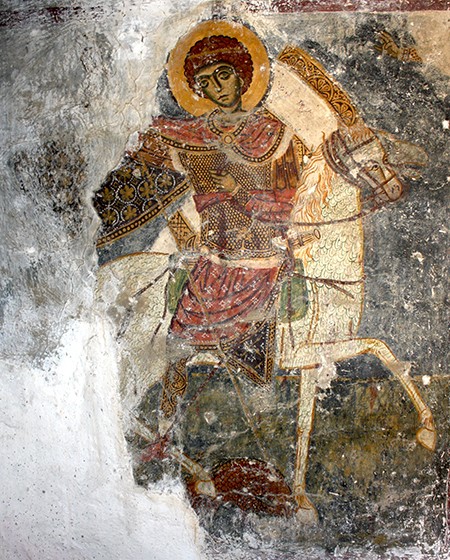In the last few decades, the late medieval Mediterranean has been the focus of a number of wide-ranging historical studies that emphasize its status as a privileged space for political, cultural, artistic, and commercial exchange between West and East. For art historians this has opened up the possibility of looking beyond long-established categories such as crusader, Byzantine, Gothic, or Muslim and allowed testing the boundaries of previously well-settled narratives of art in modern nation states. The remarkable expansion of the Crown of Aragon during the fourteenth century brought its people into contact with Byzantium (1303–1309) and Greece, where they established themselves as rulers of the duchies of Athens and Neopatras (1311–1388) and Lords of Aegina (1317–1451). This political shift engendered new intercultural identities that fostered unusual artistic encounters—a multifaceted and multidirectional phenomenon in which concepts such as appropriation, hybridization, cultural fusion, and “introjection” (a term borrowed from the field of psychoanalysis) are helpful in defining various levels of interchange.
As there is no comprehensive artistic study of the long-standing Catalan rulership in Greece, the book that I have been writing at CASVA aims to fill this gap and advance understanding of the artistic agency of the House of Barcelona in the wider Mediterranean, where the protection of pilgrims traveling to holy sites and the collecting of prestigious relics from the East seem to have been crucial elements in the special relationship between the Crown of Aragon, the Palaiologan dynasty, and the Mamluk sultanate. My analysis also includes an earlier moment, at the end of the thirteenth century, when the Iberian Peninsula was especially permeable to the arrival of objects from the eastern Mediterranean by means of the diplomacy and presence of members of the Lascaris family in Aragon. The best-known case is the treasure of the convent of Santa Clara-a-Velha in Coimbra, Portugal (Museu Machado de Castro), whose Sicilian and Venetian-Byzantine objects may have been brought to Portugal or commissioned by Elizabeth of Aragon (1271–1336), queen of Portugal (1288–1325), along with Vataça Lascaris (1270–1336), a member of Elizabeth’s court. In this context, I have thoroughly revisited the Spanish provenance of both the Kahn Madonna and the Mellon Madonna, in the National Gallery of Art collection (1949.7.1 and 1937.1.1), which came onto the art market in Madrid in 1912. These paintings, which were probably made in Constantinople in the period of the Union of the Churches (1274–1282), could have then arrived in Spain as a result of the close relationships between Michael VIII Palaiologos and the Aragonese kings.
One of the aims of my research has been to provide the methodological basis for defining the precise nature of Catalan agency in the Mediterranean and the different levels at which such interchange operated. While the maritime republic of Venice presented itself as the heir to Byzantium by looting its treasures and emulating its aesthetics and Genoa presented itself as a faithful ally worthy of imperial gifts, the realm of Aragon—conditioned by Franciscan spirituality—looked to the East as a form of sacred topography: one that connected it with the origins of Christianity and was situated where the messianic kingdom would arise at the Second Coming.
My book will present a series of case studies of Catalan artistic patronage in the eastern Mediterranean, especially those related to the appropriation of ancient monuments, the use of shared shrines, the controversy between Latins and Greeks over the image of Saint George, and the frantic quest for relics from the East. Thus, I will analyze the urban plan of Paliachora (Aegina) in Greece and, in the Holy Land, I will examine the gifts made by the Catalans to the monasteries of Saint Catherine on Mount Sinai and Saint Barbara in Cairo. Critical to these investigations is the Catalan Atlas (1375) of Abraham Cresques, which serves as a helpful tool for understanding the peculiar Weltanshauung of the Aragonese kings.
The ultimate result of this extended two-way exchange can be seen in late medieval Catalan panel painting. Central in this context are the iconography of Saint George and the reception (and invention) of acheiropoietic images, such as the Holy Measurement of Christ, the Valencian Hodegetria, the double Veronica of Christ and the Virgin, and the Mandylion. The appearance and success of the last two in Catalan painting coincided with the arrival in Catalonia of a series of diplomatic embassies from Manuel II Palaiologos (1400, 1407) as well as the earliest documentary record of trade in Byzantine icons from Constantinople, Crete, and Chios through Catalonian ports beginning in 1404.
The intercultural aspect of the Mediterranean is a potentially significant subject within Byzantine studies. Only a reconstruction of the complex network that linked western Christians with eastern Christians and Muslims will enable us to better understand this multifaceted phenomenon and the richness of its artistic agency. In precolonialist and premodern Europe art was in flux and became part of a dialogue in which every work may be seen as an act of reciprocity.
